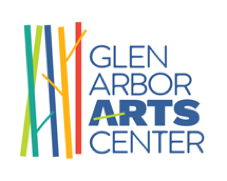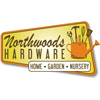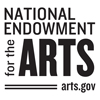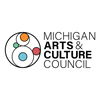
Creativity Q+A with Randi Ford
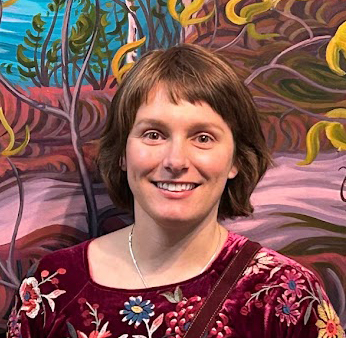
Northern Michigan is painter Randi Ford’s subject, from Sleeping Bear Dunes to Pictured Rocks. Her work is inspired by these natural places — so much so that the 34-year-old artist moved to Benzie County last summer so she could live and practice where she find artistic and spiritual nourishment. You may already know her work: One of her paintings, Path Through Time, was selected for the Glen Arbor Arts Center’s 2023 Manitou Music poster. Take a look at it here. With her husband, artist Ben Ripley, Randi has merged a last name [she’s Randi RipleyFord] and a life. “Life is art,” she said.
Pictured: Randi Ford
Describe the medium in which you work. What is your work?
I currently work with acrylic paint. I’ve been acrylic painting for the past eight years. I was using gouache, and I also experimented with oil painting. I really loved gouache, but I wanted to paint larger, and not on paper but on canvas. I enjoy acrylic because I can layer, and blend, and create a lot of line work. I figured out how to make it flow well using a flow release.
Define flow release paint.
It’s an additive to mix into the paint, but I put it in a spray bottle.
It makes it easier to move the paint around?
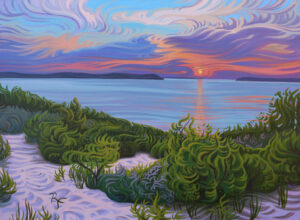
Yes. It keeps it wet longer. A lot of people struggle with acrylic because it dries too quickly. I can also get longer, smoother brush strokes.
Did you receive any formal training in visual art?
Yes. I first studied art in high school — I didn’t do it until my senior year, and all my classes senior year were art classes. We had a good program there. It’s a small school in Sturgis, Michigan. I went to Grand Valley [State University] and received my BFA in Illustration [2012], but I also touched on painting. For my senior show I did a combination of illustrative landscapes themed on the seasons of Michigan; and a series of abstract landscapes in oil.
How did your formal training affect your development as a creative practitioner?
I think college helped with creating work — we had to do so many different assignments that pushed us to develop our skills. And then, executing your vision and completing the projects helped me be able to do that on my own after I graduated. I learned how to lay out timelines, and set deadlines.
Describe your studio.
Right now I don’t have a full studio. It’s in process because we just moved up North. I have been working out of my home studio for 10 years in Grand Rapids. I had it in the basement. Then I moved into a room upstairs. In my studio I have an easel, a paint station, speakers for music, plants, stones, art objects, a few of my paintings as well — I like to create a peaceful, beautiful space. My computer and my iPad are there. I use my iPad to develop paintings, and I work from that developed image when I’m not painting outdoors.
When did you move North?
I live now in Beulah [Randi and her husband, hand engraver Ben Ripley, moved in August 2023]. I’ve been wanting to live in Northern Michigan since I started coming up here [to paint] in 2014. I’ve been getting inspiration up here, and in the Upper Peninsula. My work is inspired by these natural places. We found a home in Beulah surrounded by state land. My studio is a walk-out from the basement that overlooks the woods and the front yard. We’re putting in a slider with windows, so I’ll have a lot of natural light. His studio will be in the garage.
What themes/ideas are the focus of your work?
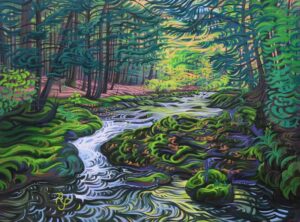
I was first drawn to nature, to paint it — I had an innate desire to replicate it, to show its beauty and wonder. Then I started working with different nature conservancies in West Michigan to create art for their [fundraising]. They [the Land Conservancy of West Michigan] have an art show called Preserved! to raise money for the nature conservancies [including Flower Creek Dunes Nature Preserve, The Highlands and Saul Lake Bog, all preserves in the Grand Rapids area]. My work allows people to appreciate the natural landscape, and hopefully want to restore their landscape or protect natural areas. That was part of my mission for my work — bringing the beauty of the landscape, and to help move forward people’s mindset of what a landscape should be. There’s also a spiritual part to the work. The desire to paint was a spiritual pulling. I feel that I’m called to bring beauty and light to others through my work.
What prompts the beginning of a project or composition?
First, it’s prompted by my different hikes in nature. It starts with the subject matter and the awe I feel, and trying to replicate that in the composition. I’ll go through my photos [taken during the hike], and find the images that create the most honest spirit to paint.
Your process involves being out in the natural world. Do you feel that directly experiencing these things comes through your paintings?
Yes. Part of it is the feeling I have when I’m in those spaces. There was only one time I referenced an image online. All the rest of the work is done from my own experience. Whatever drew me to capture that through my photograph, that’s what I want to express. I’ll try to show the spirit of the life in the plants in nature, making them feel more alive than just [representing them on canvas].
What’s your favorite tool?

The camera. But I also like to use Photoshop — I’ll it to design the scenes a little more, and edit the photos before I start painting. For painting, I use only two brush styles: the flat brush, which is squared [for line work], and round brushes to do tiny details.
Before Photoshop was invented, how would you develop the composition? Has Photoshop always been a part of your practice?
It has. Sometimes I don’t [run the photo through Photoshop]. I’ll just take the photograph, and start painting directly on the canvas. Sometimes I’ll sketch things out — I used to draw a lot for my illustrations, which I stopped doing when I got more into my painting. Sometimes I’ll do that to get the composition down. I don’t take my iPad out there.
You came of age when computerization was taking over hand work.
I was in high school when all this digital stuff was happening.
Do you have any thoughts on why making things by hand is important?
I do think that making things by hand is very important, and that’s why I won’t fully go into digital art. I use that as a tool to make my paintings better. Digital things separate people. [The connection] isn’t real life. It’s in the digital world. I can’t use the computer too much. I get hand pain in my nerves. So, I’ve made it a practice not to be on my phone or computer too much. I take breaks. I think handmade art work has more spirit in the piece. It comes to life more. There’s more of spiritual essence to the piece. If you printed out a painting online, there’s not life or emotion that you can feel. The emotive energy that is put into the piece is actually felt more in the handmade process.
When did you commit to working with serious intent?
I did that right after I graduated. I didn’t want to get a “normal” job. If I get a “normal” job, I’m going to be giving up my time and energy, and putting that into a job I’m going to leave. I’ll have to catch up. So, it’s now or never to pursue my art career. Right after, I started creating as much as I could. I had a few part-time jobs where I was balancing that side-by-side, but, eventually I was able to let go of the part-time jobs that were preventing me from doing what I wanted to do with my art. I’ve been full-time since 2017.
What kinds of part-time jobs were you working?

I worked at Jared’s, the [national chain] jewelry store. I was interested in jewelry making, and I learned how to connect with clients. I almost wanted to work as a bench jeweler, but I worked there seasonally and learned how to work with clients. I was kind of shy, and that helped me open up to strangers. And then I worked at LaFontsee Galleries [closed in 2022] in Grand Rapids in an internship. That got me more familiar with the gallery side of things, and I was using my digital skills to help them. They started carrying my work after I’d worked there for three months. I showed with them for a few years, and I was also showing in art festivals, which I wanted to do more — as well as [find representation] in galleries up North since I was painting up North. I also taught at Grand Valley for a year-and-a-half, teaching 2-D design. That was a great learning opportunity for me to teach students directly, and helped me to learn more about what I was doing by teaching that to students. I gave that up. It was a lot of work for not much money. I could make one painting in less time, and make about the same amount of money as an adjunct professor.
What’s the role of social media in your practice?
I’m not the best at social media. I wanted to use it to connect with people and gain followers who wanted to see my work. Now I use it as a gallery space. When I have something new, I’ll post it to keep people updated. I don’t want to post all the time. It distracts me from my art. It’s a trap. You have to be learning all the new things all the time. That’s a whole other job, social media.
How does living in Northern Michigan inform and influence your creative practice?
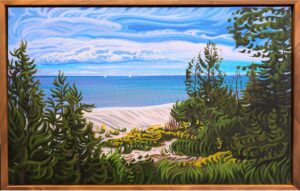
The goal with living up here was to live among the places I paint. I’ve lived in the city since I graduated from college, and moved to Grand Rapids [Michigan]. I was coming up North all the time. I lived down there, but I’d be up here for showings, to get inspiration. Once a relationship I had ended there, I decided I wasn’t going to stay in Grand Rapids anymore. There wasn’t any point to it. My family’s not [in Grand Rapids]. A lot of my friends moved away. I’ve had a lot of signs [telling her] to move up here. When I moved up here, everything fell into place. I’m hoping to connect more with other plein air painters; to get more inspiration to make stronger pieces.
Did you know anyone else, when you were growing up, who had a serious creative practice?
My grandmother wasn’t a professional artist, but she did create art her whole life. She was beautiful gardener. Cooking was an art for her. Her house was very colorful. She like to collect antiques. She didn’t paint landscapes, but did more expressive things. My dad is an industrial designer — he designs finials, the decorative end pieces for curtain rods. One of my mom’s friends made copper fountains, and sold them at art fairs. She’s how I learned about art fairs. My mom had a booth at the Shipshewana Flea Market selling antiques. I helped her, when I was young, to set up her booth.
Who has had the greatest and most lasting influence on your work and practice?
[Randi mentions a number of teacher she studied with in college, as well as Northern Michigan painter] Margo Burian — I went to her, and she mentored and encouraged me, and talked to me about the art business.Talk about the role of creating a body of work.

Creating a body of work means I’m creating a series of paintings. Each time I create a body of work it will be a little different than the last. The way I paint it changes.
So, you’re creating a group of paintings that have some relationship to one another? And when you show them, they all hold together as a unified idea?
Yes. The paintings will have the same kind of look because I create them in the same time frame.
To whom do you go when you need honest feedback about your work?
I go to Ben. I have a problem reaching out to people and asking for help. A lot of times, I critique myself; but then I’ll go to Ben. My dad’s a good critique-er. He has critiqued me throughout my lifetime, and pushed me to do better.
You exhibit your work at art fairs. When I was a more frequent visitor and exhibitor at art fairs, the exhibitors generally seemed to be older. I wondered why there weren’t more young people going this route. Talk about your experience.
Yes. I’ve been doing a combination of that and showing at art galleries. [Randi and Ben will] have a space in the future, in the barn down the road from the house, where we’ll have a gallery space. [Exhibiting at] art fairs is a way I can connect with people and share my work directly. Through galleries, you give your work to [the gallerist], and you really don’t have any way to connect with the people who are seeing the work. I like to know the people who are collecting my art work. It’s important for me.
When you’re standing in your art fair booth, you’re directly connected with the people who are looking at your work.
That’s part of it. I used to interact with people more, but now I sit off on the sideline to allow them to look at the work. I pay attention to [detect] if they want to communicate with me about the work. Or, if they’re looking at it, I’ll give them my message. I’ll have longer, deeper conversations with anyone who is looking my work, to make a deeper connection. I continue to have a relationship with them afterward through my newsletter.
Do you feel like an anomaly? Are you usually the youngest exhibitor at an art fair?
I have been the youngest for a long time. I think there are more younger artists who are starting to show. But mostly it’s older people. I’ve overheard people talking about that at art fairs. They want younger people to start coming in. They were saying that art fairs might die if we don’t get the younger generation involved. A lot of [older exhibitors] are starting to retire. But it’s harder for younger artists to get in because the art work needs to be of high quality to get into art fairs, and younger artist might not have the body of art.
How did you learn the ins and out of being an art fair exhibitor?
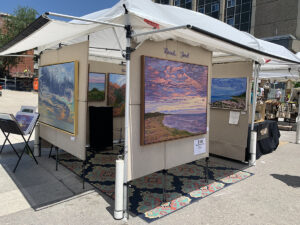
I started exhibited at church craft shows. And then I moved onto the [Fulton Street] farmers market in Grand Rapids. They have a craft show every Sunday. I slowly started learning about other art fairs from exhibitors there. I looked at other artists’ booths that I thought were strong. I used to have an E-Z Up tent, and then I invested in a Light Dome, and it looks more professional. Now, Ben and I are going to be showing together.
How do you feed/fuel/nurture your creativity?
Listening to music. I listen to music a lot when I paint. I also hike, and go on nature walks. That clears my mind. Nature inspires me, and then I get inspired to painting. Painting [brings on] a peaceful state for me, where I feel connected to spirit.
What is in in the world that drives your impulse to make?
It’s my nature. I just want to create beauty: a beautiful space, a beautiful life. Life is art.
Learn more about Randi Ford here.
Sarah Bearup-Neal develops and curates Glen Arbor Arts Center exhibitions. She maintains a studio practice focused on fiber and collage.
